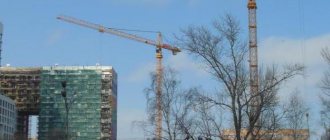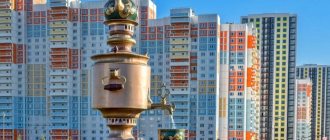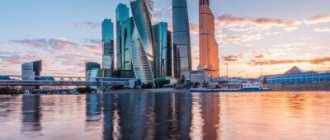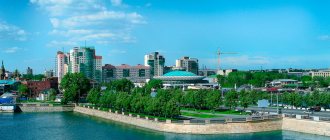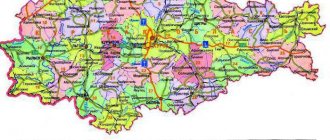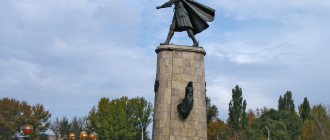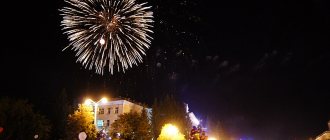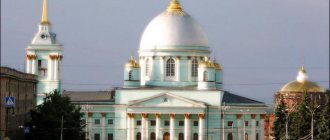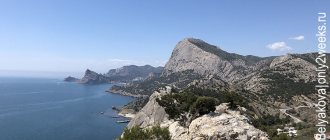- August 19, 2018
- Tips for tourists
- Catherine
Noginsk is a small city in the Moscow region with a population of 102 thousand people. This settlement is located on the banks of the Klyazma River, 50 km from Moscow. The year of foundation of the town is considered to be 1389, but at that time it had a different name (the village of Rogozhi). Now Noginsk is a regional center. This is where local townspeople and residents of nearby settlements prefer to relax. The abundance of greenery, historical attractions and entertainment make this city suitable for a good holiday. Where to go in Noginsk to get a lot of pleasant memories?
Historical landmarks
There are several attractions in and around the city that have a long history.
- School No. 10. This massive building was erected in 1908. At that time, future workers of weaving factories were trained here - it was a two-year primary school of the highest type. Only boys studied here. The first changes took place here in 1914: the school program became eight years old, and both boys and girls could study here.
- Temple of St. Sergius of Radonezh. Construction of this architectural object began in 1839. Anatoly Demidov is considered the founder of the construction. The temple received its name due to the fact that the villages of the parish were part of the possessions of the Trinity-Sergius Lavra. In the 30s of the last century, the temple was closed, and in 1991, in a destroyed state, it was transferred to the Orthodox community.
- Volkhonka Estate. This place is a unique historical and natural attraction of Noginsk, where you should definitely go. The estate was built in the 17th century as the summer residence of Prince A.M. Volkonsky. This person belonged to the family from which came: the mother of L.N. Tolstoy, the Decembrist S.G. Volkonsky and other respected people. Another important detail is that the estate was a favorite vacation spot of M. Yu. Lermontov. The poet had tender feelings for the daughter of the owner of this residence.
What to see, where to go as a tourist
For those who like to be organized, the city offers tourist excursions. But for those who want to take a walk on their own, this locality is also suitable. I recommend staying here, since it is difficult to see the sights in Noginsk in one day.
Chernogolovsky Pond
This quiet place is suitable for family holidays and walks with children. The pond is shallow and surrounded by forest. Here you can have a picnic, barbecue, or just sit with a book.
The pond is especially popular with fishermen because there is a good catch here. In winter, the surface is cleared of snow and people come here to skate.
Chernogolovsky Pond is loved by locals for recreation and fishing.
House-museum of the family of A. I. Morozov
Patrons of art, collectors and the richest industrialists in Russia are the Bogorodsk merchants Morozovs. There is a museum in their house.
At the beginning of the 20th century. the building was designed by architect A.V. Kuznetsov. An ancient house in the late Moscow Art Nouveau style, a glazed attic overlooking the beautiful Chernogolovsky pond, creates a cozy atmosphere.
Until 1919, the Morozovs lived here, then the building was transferred to the Soviet authorities.
For some time the house was in disrepair, although the structure itself did not undergo changes. The building has now been restored and excursions are held here today.
The house-museum of the A.I. Morozov family is in good condition and welcomes tourists.
Museum of Local Lore
The Noginsk Museum of Local History contains a collection of archaeological finds. Within its walls are exhibited paintings by painters of the 19th and 20th centuries. Documents, ancient photographs, and household items that reflect the history and culture of the city are stored here.
You will also like: Sights of Arkhipovo-Osipovka: top 10 beautiful places
The museum has several halls for visitors:
- Archeology and geology. Among the exhibits you can see stone tools, arrowheads, ceramic dishes, etc.
- Nature. Stuffed animals living in the area are kept in the hall.
- Stories. Among the exhibits are ancient weapons, merchant clothing, furniture, weaving machines, etc.
The local history museum presents several exhibitions.
House of B. Pilnyak
On Rogozhskaya Street it is not difficult to notice an old house with neat architraves, a fence and the signature “Pilnyak House”. In this building from 1904 to 1912. the Soviet writer lived and worked.
The house is built entirely of wood and has 2 floors. Its facades are painted dark yellow, and its metal roof is visible from afar thanks to its bright red tone.
B. Pilnyak's house is built of wood.
Lover's Bridge
One of the most romantic sights of Noginsk is located above the Tura River. Girls and boys in love have long chosen the pedestrian bridge as a meeting place. Symbols of their love—small locks—hang on the balusters. Photo sessions are often held here, so the bridge is never empty.
The romantic landmark of the city is the Bridge of Lovers.
Fountain area
The main decoration of Noginsk is the central square - the place where residents and tourists gather. There are light fountains of different sizes here. Flowers grow around them and green lawns are laid out.
Now the main attraction is not available for visiting, because... is under reconstruction. But you can walk next to it along the main street.
The fountain area is under reconstruction.
Epiphany Cathedral
The cathedral, built in the 19th century, is an example of severity and beauty at the same time. It was reconstructed several times, but it did not immediately have a bell tower.
The interior decoration is striking in beauty:
- iconostasis;
- carpets;
- paintings;
- panicked.
Believers should visit this landmark of Noginsk.
The Epiphany Cathedral receives believers every day.
Tikhvin Temple
The city is also home to this beautiful Orthodox church, whose history is dramatic. For some time he did not have his own official parish. The building could not be completed and consecrated. Later they actively began to decorate it, but all efforts were in vain.
With the advent of Soviet power, the cathedral was destroyed and remained closed for a long time.
The bell tower and several chapters were destroyed. Only after the collapse of the Soviet Union did the revival of the Tikhvin Church begin. Now prayers are being heard here again. Anyone can visit the shrine and look at the beauty of the interior decoration.
You will also like: Where is the best place to relax in Sochi in October
Divine services are held in the Tikhvin Church.
Assumption Church
There are quite a lot of churches of the Dormition of the Virgin Mary in Russia. They are all different, but Noginskaya is worth a look, since the city previously even bore the name Bogorodsk.
The church is considered the object of charity of the merchant G. P. Klyuev. It was built in the middle of the 18th century, when the settlement was still a village. The shrine was under reconstruction for some time. It is now equipped with a central heating system.
The Assumption Church was built in the mid-18th century.
Estate "Volkhonka"
It is located in the vicinity of Noginsk. In the 17th century the estate was a house of 2 floors and belonged to the Volkonsky family. Until the end of the 18th century. the territory was registered with them, then passed to other owners. Later Volkhonka was nationalized. Now all that remains is ruins.
All that remains of the once famous Volkhonka estate are ruined walls.
Natural attractions
Where to go in Noginsk after viewing historical monuments? In the vicinity of the city you can have a great time in nature.
- Lake Lukovoe. According to data obtained after studying the bottom soil, this reservoir was formed more than 10 thousand years ago. The lake has a ring shape, as in its very center there is a small overgrown island. On the shores you can often meet vacationers and fishing enthusiasts. There is a guarded parking lot and a cafe.
- Waterfall “Gremyachiy”. According to legend, this natural miracle appeared more than 600 years ago in the place where Sergius of Radonezh stopped to rest. The waterfall is nothing more than a source of mineral water, where all local residents and guests of the city strive to go in Noginsk. Everyone can swim in the font or directly under the waterfall.
Monuments in Noginsk. When were they installed and what are they dedicated to?
Memorial of Glory in Noginsk
All residents of the Bogorodsky District are well aware of our main square, Victory Square, where all significant events are held. But, probably, not everyone knows that it received this name more than 40 years ago, when on May 9, 1974, the Glory Memorial with the Eternal Flame was opened in Noginsk. The author of the monument is Pyotr Vasilievich Peretynkin.
This is how this event is described in the newspaper “Banner of Communism”: “Thousands of residents of our city gathered on May 9 in the new square, where a rally was held dedicated to the opening of the Monument of Glory to the Noginsk residents who died during the Great Patriotic War. The meeting was opened by the chairman of the executive committee of the city council, Comrade. Titov M.I. From now on, he says, this new square, where the monument of Glory is erected, will be called Victory Square.<…>To the sounds of the National Anthem and volleys of fireworks, the covers fall off the monument, and the monument of Glory appears before the eyes of thousands of people.”
In 1973, the artist Pyotr Peretynkin was given a special room, where he, together with Evgeny Dyumin, sculpted bas-reliefs in clay, molded them in plaster and filled them with concrete. Intense work was carried out for eleven months. On the 14-meter stele was inscribed: “Glory to those who fell in the great struggle! Let their work be the work of the living!” On one side of the stele there is a mother with a child, on the other there is a soldier with a machine gun. The eternal flame at the memorial was lit by Hero of the Soviet Union, anti-aircraft gunner, NZTA employee Vasily Alekseevich Chernoshein (1924-2002).
On May 9, 1980, urns with soil from 11 hero cities were installed near the monument - Moscow, Leningrad, Volgograd, Odessa, Kiev, Brest, Sevastopol, Novorossiysk, Minsk, Kerch, Tula. This land was brought to Noginsk and walled up for eternal storage in special cartridges by Noginsk residents who distinguished themselves in the defense of hero cities. Among those who laid the capsules were Heroes of the Soviet Union A.S. Pleshakov, V.A. Chernoshein, holders of the Order of Glory A.G. Krupnov, V.I. Sharov army veterans V.F. Pompa, L.N. Mishin, N.G. Pavlov and others. For the 40th anniversary of the Victory, plaques were installed with the names of the units that went to the front from Noginsk and the places where there were military hospitals. 30 marble pylons with the names of fellow countrymen - Heroes of the Soviet Union - were later placed here. On May 9, 1995, the regional “Book of Memory” was laid in the sarcophagus of the Victory Memorial.
In memory of all the soldiers who did not return from the battlefields, a chapel was erected on Victory Square in 1998. The brick plastered chapel was built according to the design of V.A. Drozdova with the assistance of the head of the Noginsk region V.N. Laptev and with the blessing of His Eminence Juvenaly, Metropolitan of Krutitsky and Kolomna. On May 9, 1998, in front of a large crowd of people, Bishop Yuvenaly, in the co-service of the clergy of the Noginsk deanery, consecrated it. On military-patriotic holidays, memorial services are held near the chapel. The chapel is oriented from west to east. Above the entrance is the image of the Savior Not Made by Hands - a mosaic icon by Moscow artist Konstantin Zaviralin (he also created the image of Our Lady of Vladimir on the stele at the entrance to Noginsk). Inside the chapel there is a cross as a symbol of memory and a lamp is lit. Under the cross there is an inscription: “This chapel was erected with donations from the servants of God Vladimir and Gleb.”
MONUMENT "ZENITKA"
Located at the intersection of Tekstil and Dekabristov streets in Noginsk.
Of the approximately 9,000 enemy aircraft that took part in the raids on Moscow, less than 3% broke through to the city; 1,305 found their deaths on the outskirts of the capital, which was guarded on all sides. One of these areas of defense was the eastern one, which at that time covered important defense facilities in the cities of Elektrostal, Noginsk, Pavlovsky Posad, Elektrogorsk and the territory of the Noginsk region. Directly in this area, the sky from attacks by fascist bombers was guarded by soldiers of the 347th Anti-Aircraft Artillery Regiment of the Special Moscow Air Defense Army, who prevented enemy pilots from dropping a single high-explosive bomb on industrial facilities and residential areas in Elektrostal and Noginsk. Only two fascist bombs fell on the territory of the city behind the railway station.
After the war, the initiators of the installation of an anti-aircraft gun in Noginsk were the former commander of the regiment battery, the chairman of the council of veterans of the air defense unit, Ivan Andreevich Katyushin, and his deputy Vera Mikhailovna Kudryavtseva. On May 7, 1980, the opening of the Zenitka monument took place. By May 9, 2010, the monument was updated.
MONUMENT "FRONT-REAR"
The monument “Front - Rear” on Lenin Square in Glukhov is dedicated to the home front workers, Glukhov workers.
The largest enterprise in the region, the Glukhovsky Cotton Mill, was one of the first to produce military products: fabrics for army uniforms, raincoats, parachutes, tarpaulins, straps for duffel bags, gas masks, sanitary bags, harnesses for horse traction. Also, with the beginning of the siege of Leningrad, where almost all the country's thread factories were concentrated, Glukhovka received the task of supplying the entire clothing industry with threads.
In the very first months of the war, hundreds of women became assistant foreman and repairers, sizing workers and carters - they worked in the place of men. Short-term courses for retraining personnel were opened in the workshops; the Stakhanovites combined professions and switched to multi-machine service. For successful work during the war years, the plant was awarded the Challenge Red Banner of the State Defense Committee five times, and nine times Glukhovites won first and second places in the All-Union competition. In 1944, 22 employees of the plant were awarded orders and medals of the Soviet Union. During all the years of the war, about 5 thousand people went to the front from Glukhovka, 197 workers of the Glukhovsky plant did not return from the battlefields.
To build the monument on the square, a dilapidated two-story barracks was dismantled. The monument to home front workers was opened on the eve of the 40th anniversary of the Victory of the Soviet people in the Great Patriotic War. The author of the monument is Pyotr Vasilievich Peretynkin.
MEMORABILITY SIGN AT THE SITE OF THE MILITARY RECRUITMENT OFFICE
Installed on the street. Trudovaya opposite house 6.
At the beginning of the last century, this place was built up with wooden houses. In one of them, on September 15, 1918, by order of the Bogorodsky district commissariat for military affairs, a military registration and enlistment office was opened.
With the beginning of the war, already in July 1941, the Noginsk military registration and enlistment office (military commissar Sergeev) began forming militia units; 2,200 volunteers were selected. In total, about 37,000 people were sent to the front during the war years. The military registration and enlistment office monitored the fates of fellow countrymen sent to the front. Triangular envelopes from the fronts and from hospitals, notices and funerals often arrived here.
Now on the street Trudovoy is a modern 9-story building, and on the site where the military registration and enlistment office stood there is a memorial sign. The new military registration and enlistment office building is located nearby, on Airborne Paratroopers Street.
Read the special issue “Victory in the Faces” here.
Source:
https://innoginsk.ru/specproekty/pobeda-v-licah/pamyatniki-v-noginske-kogda-ustanovleny-i-chemu-posvyashcheny
Where to go in Noginsk with children
On weekends, you can take a walk around the city with the whole family - the children will definitely be delighted.
- Alley of fairy tales. In 2007, a whole alley appeared in the city cultural park, where cartoon and fairy tale characters live. Children will meet Cheburashka and Gena the Crocodile, little Mammoth, Smeshariki and many other characters from Soviet and modern cartoons.
- The natural resort of Yakhonty is located a 15-minute drive from the city. This route is worth recommending to all those who are looking for where to go with a child in Noginsk.
The territory is a small zoo where adults and children can see horses, rabbits, camels, peacocks and many other animals.
